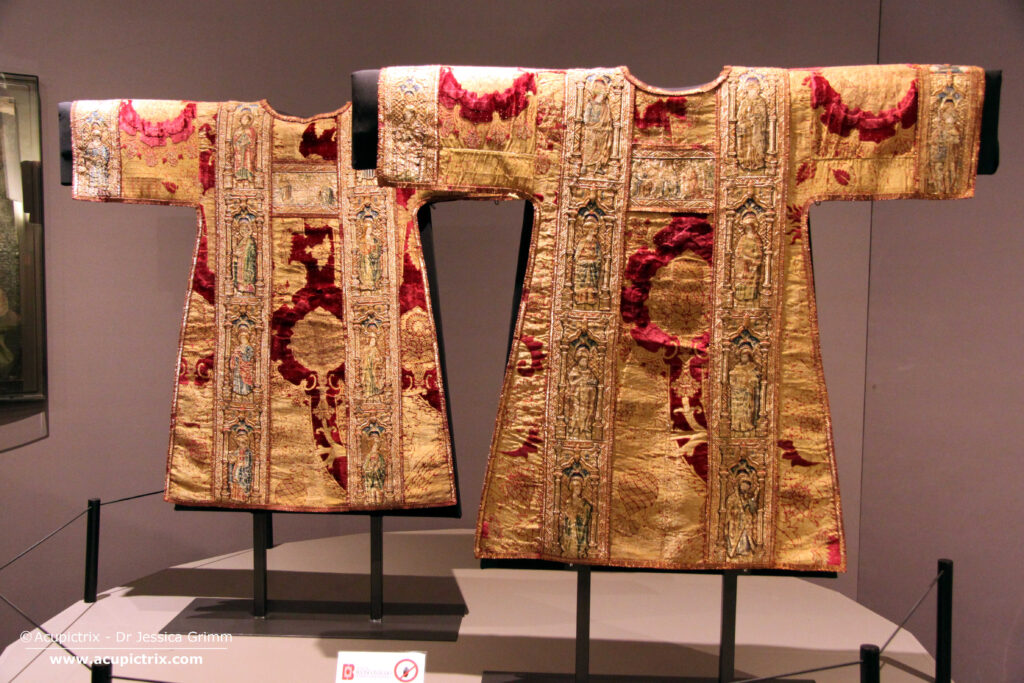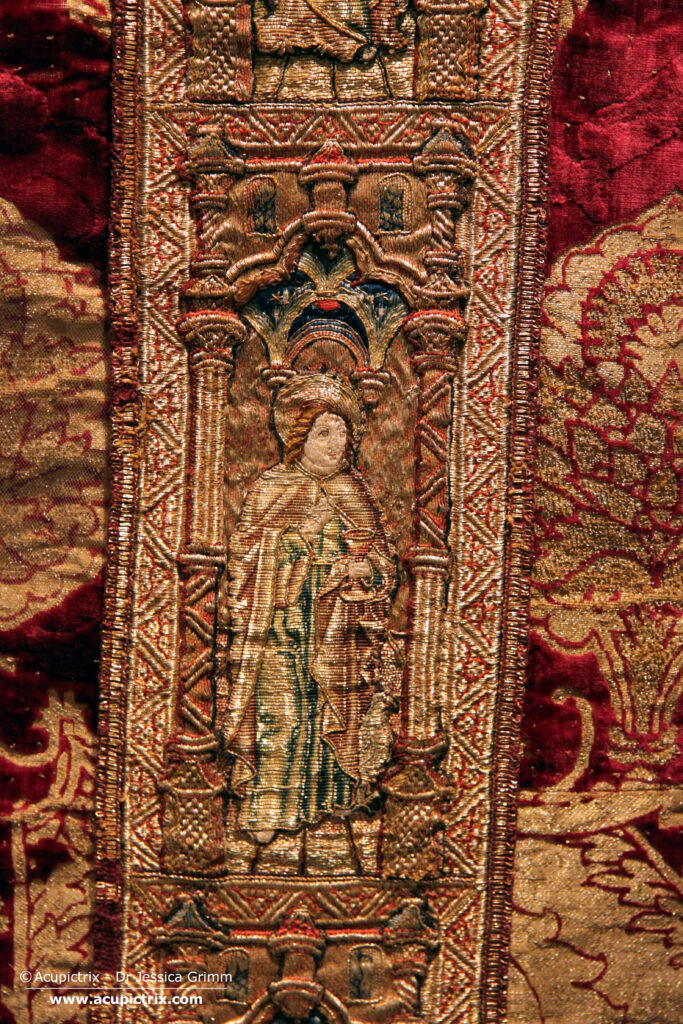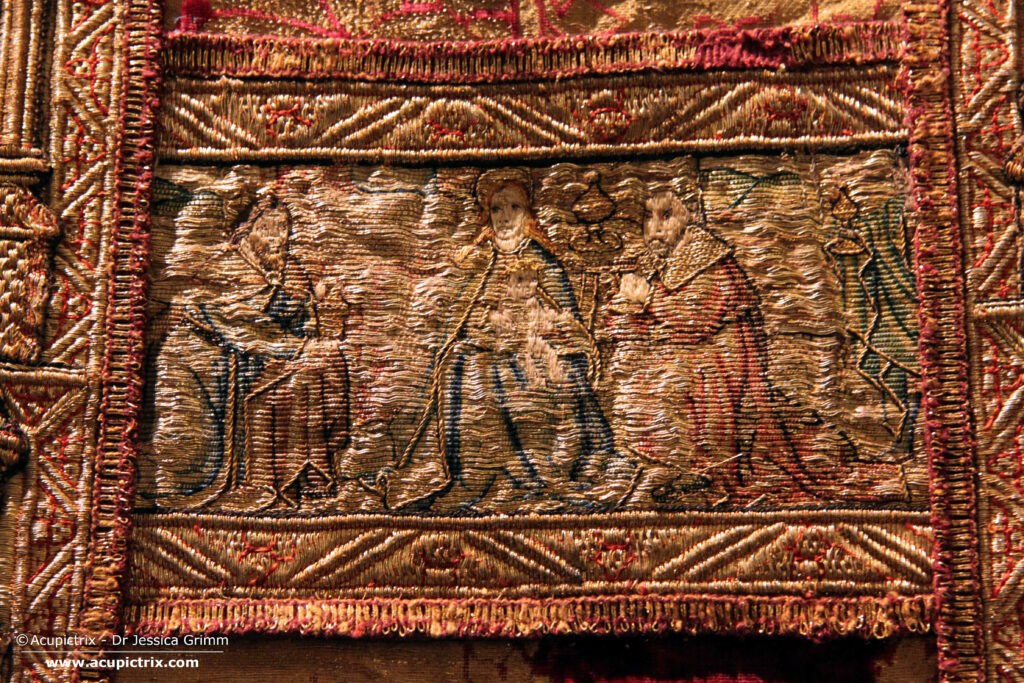This month, we will focus on late medieval goldwork embroidery from the Netherlands. These can be found in collections and church treasuries all over the world. Like Opus anglicanum in earlier times, late medieval goldwork embroidery from the Low Countries was highly sought after. The embroidery workshops in major centres such as Utrecht, Amsterdam and Haarlem were streamlined through labour division. High-quality mass-produced orphreys were the result. In 2005, the Museo del Castello Buonconsiglio in Trento, Italy, purchased two such vestments on the antiques market. Let’s explore the beautiful or nué (shaded gold) embroidery.

The Italian museum bought two beautifully embroidered dalmatics (111 x 128 cm), the vestment worn by the deacons during Mass. The dalmatics were once likely part of a set with a chasuble and a cope. The carefully placed pieces of valuable Florentine velvet underline their ‘set’ character. The medieval goldwork embroidery consists of orphreys placed in the typical H formation on each vestment’s front and back and at the end of the short sleeves. The embroidery was made in the first quarter of the 16th century at a workshop in either Utrecht or Amsterdam.

at Castello Buonconsiglio, Trento, Italy.
The orphreys on the set of dalmatics are clearly a product of mass-produced late medieval goldwork embroidery. The same figure could be morphed into a different saint by varying the colours and attributes. But that’s not all. The exact same figures are present on both dalmatics! As a result, there doesn’t seem to be a particular canon of figures present. We have apostles, doctors of the church and common, very popular, late medieval saints.
The medieval goldwork embroidery itself is of high quality. We have beautiful or nué for the figures, a lovely golden background with a red diaper pattern, and fine silk embroidery for the faces. The hands have been silk-shaded on top of the gold threads (gilt passing thread) forming the or nué.
The figure and the background were worked separately on pieces of linen. The embroidery is voided below the figure to save on labour and materials. Parts of the architectural background have been worked separately and then applied to create a little depth. This is further enhanced by edging the figure and key parts of the architecture with dark brown silk.

at Castello Buonconsiglio, Trento, Italy.
In the orphrey above, with the Adoration of the Magi, you see further proof of the ready-made nature of these medieval goldwork embroidery orphreys. The Nativity scene was too wide for the vestment. The embroidery extends under the vertical orphreys. In the process, half of the dark-skinned king on the right got covered over. As we say in Dutch: “Foutje, bedankt!“.
A larger church likely bought the finished orphreys through a merchant, either in the Netherlands or elsewhere in Europe. Unfortunately, we don’t know to which church inventory these dalmatics once belonged. The vestments were skillfully made by a tailor who likely had no contact with the embroidery workshop. The tailor was presented with the orphreys and had to adapt them slightly to fit the vestments. This resulted in a high-quality set of dalmatics fit for an important (wealthy!) church.
Literature
Prá, L. Dal, Peri, P., 2019. La coppia di dalmatiche del museo del Castello del Buonconsiglio: tessuti italiani e ricami olandesi, in: Prá, L. Dal, Carmignani, M., Peri, P. (Eds.), Fili d’oro e dipinti di seta. Velluti e ricami tra Gotico e Rinascimento. Castello del Buonconsiglio, Trento, pp. 154–169.

Helle Jessica! Again it’s so interesting to follow you when exploring and explaining the details of the embroidery. I never would have realised the half covered king! This evidence of non-perfection makes makes me smile….. It makes this super adorable work and their creators human and more approachable in a certain way. I like it. Hope it translates what I want to say 😅